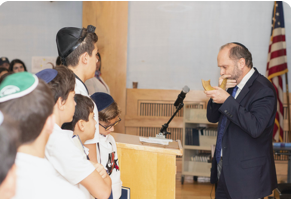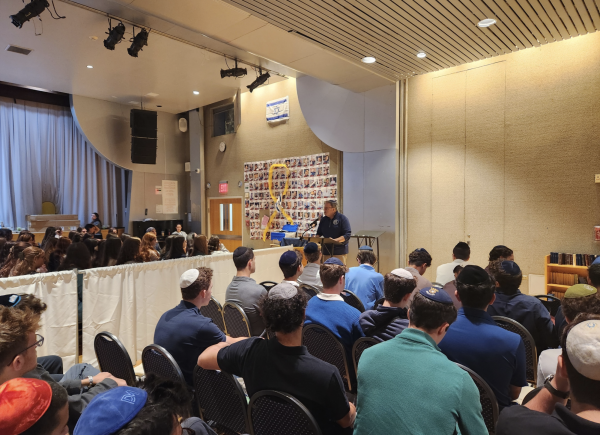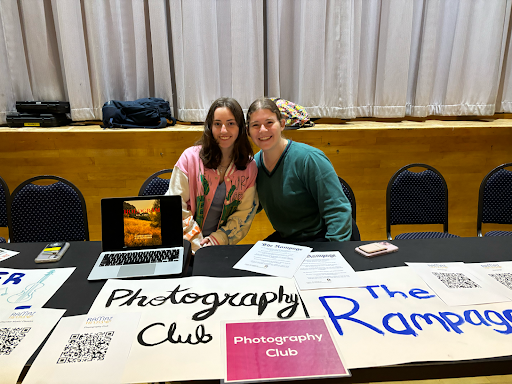Ramaz Freshmen Hear the Shofar That Survived Auschwitz

Ramaz students have been fortunate enough to meet survivors of the Holocaust, but rarely have they seen, heard, or touched religious artifacts from this low point in human history. For thousands of years, the shofar has symbolized our relationship with God and Jewish history. On a special class trip, Andrew Boyarsky ’23 was given the honor of blowing a shofar that survived Auschwitz on the Friday preceding Rosh Hashanah. This specific shofar belongs to the family of survivor Cheskel Tydur who carried it out of Auschwitz 74 years ago. Tydur was given the shofar on a death march when the Nazis were attempting to escape the advancing liberating armies and forcing their Jewish prisoners deeper into German territory. The unknown individual, who would not survive the march, gave the shofar to Mr. Tydur for safekeeping and passed on the obligation of sharing the story of the shofar and the Jewish people in Auschwitz.
The Tydur family recently lent this shofar to The Jewish Heritage Museum—A Living Memorial to the Holocaust in New York with the condition that it would be blown in Jewish communities every Rosh Hashana and Yom Kippur. On September 25, the ninth grade had the opportunity to fulfill the family’s wishes and hear the cry of the shofar that survived World War II.
Rabbi Steinmetz of KJ, whose mother was a Holocaust survivor, spoke about the shofar. He explained that it was hidden from the Nazis and blown on Rosh Hashanah in Auschwitz. He said that the shofar represents the memories of the Jews who suffered, but it was also their message of hope; they made sure to pass it along to those who survived the death march from Auschwitz. Rabbi Steinmetz explained, “No matter the sound the Shofar makes, it shakes the heavens.”
Present at the event were two Holocaust survivors, Mr. Bernheim and Ms. Roth, both well into their 90s. They instructed students to remember what they’ve learned about the Holocaust, particularly from survivors, in order to fight Holocaust deniers. They reminded students to appreciate the Jewish communities that survivors rebuilt after all of the terror that they went through. Mr. Bernheim, the grandfather and great-grandfather of Ramaz students, added that this rings especially true today because fewer and fewer witnesses to the Holocaust are alive. He stated that antisemitism is a disease, and he hopes for his speaking to help fight hatred, racism, and evil in order to make the world a better place.
Clemi Roth ’22, the granddaughter of Rachel Roth, also spoke to the ninth grade. She said that she “has grown up with [her] Savta’s first-hand accounts of the Holocaust” and read an excerpt from a piece her grandmother wrote, entitled Here There Is No Why, which described the last time Rachel heard the shofar during the Holocaust in Warsaw, Poland as the Germans were invading.
“Saturday, September 23rd 1939 arrives, Yom Kippur. On this Day of Atonement, the synagogue is overflowing with people. The men, wrapped in their white robes and prayer shawls, pray fervently. Women are sobbing, asking God to take pity on us. The children are whining in fear… Evening falls, and the prayers and fasting come to a close. I hear the wail of the Shofar. Outside, the shooting continues. Houses are collapsing, burying victims alive.”
As the ceremony concluded, Andrew Boyarsky from the ninth grade was called up to blow the shofar. He was able to squeak out very soft notes. Next, Rabbi Lookstein ’49 was asked to give it a try, and he too was only able to make soft blasts.
Despite several attempts, the shofar was squeaky and soft. It delivered a somber emotional tone. This shofar used in secret has a message and a deliberate story to pass on. Perhaps it will always emit soft, hoarse notes as it did in Auschwitz. As the shofar wails its message, the people of today’s generation must continue to tell survivors’ stories, make sure to remember what happened to our people and make sure that a tregedy like the Holocaust never happens again.


